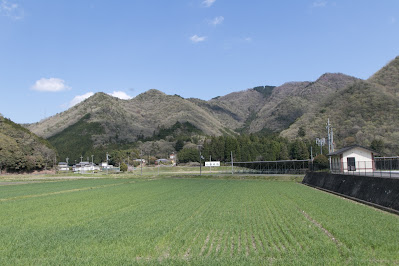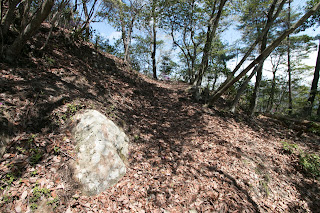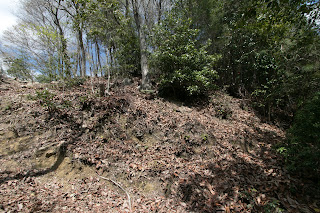Shirohata Castle
-White flag castle did not raise white flag--
Overview
Name: Shirohata castle (Shirohata-jo) / Shirahata castle (Shirahata-jo)
Alias:
Place: Shirohata Kamigori town, Hyogo
Type: Mountain Castle
Built: 1335
Remaining remnants: Stone walls and clay walls
Title:
Brief History
Shirohata castle (白旗城) is built at the peak of Shirohata-yama mountain, one of about 400 meter height from hillside near the western border of current Hyogo prefecture. Akamatsu providence where Shirohata castle stands is a narrow valley of Chikusa-gawa river, which flows along the western border of Hyogo prefecture from north to south.
Important place of communication
From the western border of current Hyogo prefecture to the middle part of current Okayama prefecture, towns spread along with large rivers flows from Chugoku mountains toward south. Main stream of rivers were used as a route from coast area to mountain area, and tributaries of such rivers were used as a route of east and westward.
Akamatsu area is exactly applicable to this situation. Main stream of Chikusa-gawa river was a connecting route of Ako area at the coast and Sayo area where was junction toward Mimasaka province (north part of Okayama prefecture) or Inaba province (eastern part of Tottori prefecture).
On the other hand, Sanyodo road which was most important road in medieval era which connected Kyoto city and Hakata city equivalent to current Route 2 ran just the south of Shirohata castle, further north from current route. Other than them many roads from different places gather at this place, thus Akamatsu providence was an important point of communication in medieval era.
Rise of Enshin Akamatsu
Shirohata castle was built in 1333 or 1335 by local lord Akamatsu clan. Akamatsu clan is said as a descendant of Emperor Murakami (926-967) but their origin is not clear and sometimes said as a maritime merchant group gained wealth at the marine trade of Seto-Naikai sea. Anyway in Kamakura era, Akamatsu clan served to Rokuhara Tandai, a branch office of Kamakura Shogunate at Kyoto city.
In 1333, Emperor Godaigo (1288-1339) and his son Prince Moriyoshi (1308-1335) issued the order to defeat Kamakura Shogunate, and Norimura Akamatsu (1277-1350, famous as his Buddhist name Enshin) responded this order and raised anti Shogunate army. The reason of this rise is unknown but there might be economic conflict between Shogunate and Akamatsu clan.
Enshin marched toward Kyoto city and broke overwhelming Shogunate army by guerilla tactics. Once Norimura entered into Kyoto city but could not keep it by limitation of soldiers, thus Shogunate army and Norimura faced at the west of Kyoto city.
Unrewarded contribution to Emperor
Looking at this situation, Kamakura Shogunate sent reinforce army lead by their relative Takaie Nagoe (?-1333) and the largest retainer Takauji Ashikaga (1305-1358). Both army fought at current Yamazaki area, and Sayo clan which was the retainer of Akamatsu clan shot Takaie Nagoe and killed.
Looking at the loss of commander, Takauji Ashikaga who was dissatisfied as a retainer of Ashikaga Shogunate decided to leave it and belong to Emperor Godaigo. Takauji and Norimura cooperatively attacked Kyoto city and fell Rokuhara Tandai, and hearing this news Yoshisada Nitta (1300-1338) finally ruined Kamakura Shogunate in Kanto region.
However, under Emperor Godaigo new government, Norimura was not fully rewarded as a vanguard to defeat Kamakura Shogunate. Prince Moriyoshi who was close to Norimura was purged, and Norimura lost the position of the governor of Harima province (Hyogo prefecture).
Turn to Muromachi Shogunate
When Takauji Ashikaga also left Emperor Godaigo government and tried to establish his own Shogunate, Norimura belonged to Takauji. In 1335 Takauji who once marched to Kamakura city to subjugate the revolt of former retainers of Kamakura Shogunate, formally left Godaigo government and marched toward Kyoto city.
Takauji once captured Kyoto city but facing the chase of Akiie Kitabatake (1318-1338) who made over 600 kilometer march from Tohoku region to Kyoto city and Yoshisada Nitta, thus was broken by both generals and once escaped to Kyushu island. Norimura still supported Takauji then stayed at Akamatsu area to earn time for Takauji.
At this time Norimura built Shirohata castle, probably using existing mountainous temples. As a tale at this time Norimura saw three white flags flaps over Shirohata-yama mountain and felt it as a lucky sign, thus decided to build Shirohata (means white flag) castle at that place.
White flag castle did not raise white flag
As Akiie Kitabatake had to return to his territory after long excursion, Yoshisada Nitta lead 50,000 soldiers and encircled Shirohata castle in 1336. Norimura made fake surrender to Yoshisada and earn the time to prepare for the battle, then furious Yoshisada fiercely attacked Shirohata castle but suffered severe damage by archers of Akamatsu army. Shirohata castle stood over 50 days and did not raise white flag.
During this time Takauji landed to Kyushu island and broke Emperor Godaigo side lords the recovered his army, then marched to Kyoto city only in three month. Frightened Emperor Godaigo sent Yoshisada Nitta and Masashige Kusunoki (1294-1336), but Emperor army was broken by Takauji at the battle of Minatogawa then Masashige killed himself.
Now Takauji returned to Kyoto city and established Muromachi Shogunate under the North Court, and Emperor Godaigo escaped to Yoshino area and opened the South Court. Under Muromachi Shogunate, this Akamatsu clan was fully rewarded and achieved the governor of Harima province and Settsu province (Osaka prefecture).
Later Akamatsu clan lost the governor of Settsu province but achieved Bizen province and Mimasaka province, then prospered as one of four major feudal lords under Muromachi Shogunate. When the South Court army temporally occupied Kyoto city, the successor of Shogunate once escaped to Shirohata castle, and Shirohata castle might have been expanded as a main base of major feudal lord.
Structure of Shirohata castle
Shirohata castle is built over the long and narrow ridge of mountain continues over 500 meter from northeast to southwest. Central area of the castle is a round shaped area of about 40 mete diameter, at the peak of the mountain. At the north of central area, there is a third area of triangle shaped terrace which guarded backside of the castle.
At the south of central area, there is long and narrow space said as a riding space, and secondary area which is about 40 meter square and having upper and lower terraces. These terraces have well formed flat space and might be reformed in later period. Further at the south of secondary area there is a front fort named Kushihashi-maru, which might keep original style of the castle.
At the eastern slope of secondary area, there is a flat space called as Samurai-Yashiki. This area might be used as a ground of the residence of the lord, and edge of this area is protected by stone walls. At this area there is a bulk of stones which originally formed pond of Japanese garden. The size and structure of Shirohata well shows the power of Akamatsu clan in the former half of Muromachi era.
Turbulence of Akamatsu clan
However, Akamatsu clan experienced hard luck in the latter half of Muromachi Shogunate. Yoshinori Ashikaga (1394-1441), the sixth Shogun and who aimed at his monopoly, purged many feudal lords. At last Yoshinori tried to deprive the territory of Akamatsu clan and give it to its branch family.
In 1441, Mitsusuke Akamatsu (1381-1441), the leader of Akamatsu clan, invited Yoshinori to his residence in Kyoto city and assassinated Yoshinori. Akamatsu clan made besiege at Kinoyama castle at current Tatsuno city, but was subjugated as an official enemy then Mitsusuke killed himself.
Akamatsu clan once lost their territory but later came back as a governor of Harima, Bizen and Mimasaka province by activation of former retainers and contribution to the battle of Onin. However, this restored Akamatsu clan lost its power by continuous internal conflicts, and depended on its vice governors such as Uragami clan or Bessho clan.
Disappearance of Akamatsu clan and Akamatsu clan
Soon Akamatsu clan and Uragami clan struggled at the western part of Harima province and Bizen province. Yoshimura Akamatsu (?-1521) tried to establish his own authority the attacked Iwaya castle of Mimasaka province from Shirohata castle, but was assassinated by Uragami clan and failed.
Further in 1538, Amago clan which was the lord of Izumo province (Shimane prefecture) intruded into Harima province, and Akamatsu clan totally lost its authority.
Around this time Akamatsu clan moved their main base to Okishio castle (Hyogo prefecture) where could gain the support from remaining retainer Kodera clan, and Shirohata castle might be abolished. Akamatsu clan itself also disappeared by 1580, except for several survivors.
Now all building was lost but structure of the castle well remain on the mountain. Compared with other main bases of Akamatsu clan such as Okishio castle or Mitsuishi castle (Okayama prefecture), Shirohata castle is not so technically built. But long lines of terraces built over tall mountain well shows undoubtedly Akamatsu clan was one of the main actors in the former half of Muromachi era.
Access
60 minutes walk from JR West Sanin-Honsen line Kamigori station to entrance of climbing road. 30 minutes drive from Chugoku Jidoshado Expressway Sayo interchange.
Related Castles
Okishio Castle -Another prominent castle at Himeji area-
Mitsuishi Castle -Castle at various borders-
Iwaya Castle (Mimasaka) -Castle fought with enemy of all directions-






























































































































































































































































































































No comments:
Post a Comment